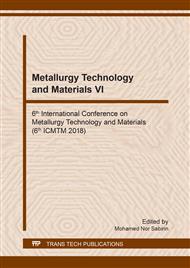[1]
Wang, X., Liu, Q., Yan, H., et al., Piezochromic luminescence behaviors of two new benzothiazole-enamido boron difluoride complexes: intra- and inter-molecular effects induced by hydrostatic compression. Chemical Communications 51.35 (2015).
DOI: 10.1039/c5cc01902h
Google Scholar
[2]
Qi Q, Liu Y, Fang X, et al., AIE (AIEE) and mechanofluorochromic performances of TPE-methoxylates: effects of single molecular conformations. Rsc Advances 3.21 (2013): 7996-8002.
DOI: 10.1039/c3ra40734a
Google Scholar
[3]
Yoshii, R., K. Tanaka, and Y. Chujo, Conjugated Polymers Based on Tautomeric Units: Regulation of Main-Chain Conjugation and Expression of Aggregation Induced Emission Property via Boron-Complexation. Macromolecules 47.7 (2014): 2268-2278.
DOI: 10.1021/ma500082e
Google Scholar
[4]
Li W, Matthews C C, Yang K, et al. Autonomous Indication of Mechanical Damage in Polymeric Coatings. Advanced Materials 28.11 (2016): 2189-2194.
DOI: 10.1002/adma.201505214
Google Scholar
[5]
Kwon M S, Gierschner J, Seo J, et al. Rationally designed molecular D-A-D triad for piezochromic and acidochromic fluorescence on-off switching. Journal of Materials Chemistry C 2.14 (2014): 2552-2557.
DOI: 10.1039/c3tc31938e
Google Scholar
[6]
Etter, M.C., Encoding and decoding hydrogen-bond patterns of organic compounds. Accounts of Chemical Research 23.4 (1990): 120-126.
DOI: 10.1021/ar00172a005
Google Scholar
[7]
Zhang H Y, Zhang Z L, Ye K Q, et al. Organic Crystals with Tunable Emission Colors Based on a Single Organic Molecule and Different Molecular Packing Structures. Advanced Materials 18.18 (2006): 2369-2372.
DOI: 10.1002/adma.200600704
Google Scholar
[8]
Yang M, Zhang Y, Zhu W, et al. Difunctional chemosensor for Cu(ii) and Zn(ii) based on Schiff base modified anthryl derivative with aggregation-induced emission enhancement and piezochromic characteristics. Journal of Materials Chemistry C 3.9 (2015).
DOI: 10.1039/c4tc02616k
Google Scholar
[9]
Luo J, Xie Z, Lam J W Y, et al. Aggregation-induced emission of 1-methyl-1,2,3,4,5-pentaphenylsilole. Chemical communications 18 (2001): 1740-1741.
Google Scholar
[10]
Ye K, Wang J, Sun H, et al. Supramolecular Structures and Assembly and Luminescent Properties of Quinacridone Derivatives. The Journal of Physical Chemistry B 109.16 (2005): 8008-8016.
DOI: 10.1021/jp0444767
Google Scholar
[11]
Dong Y, Xu B, Zhang J, et al. Piezochromic Luminescence Based on the Molecular Aggregation of 9,10-Bis((E)-2-(pyrid-2-yl)vinyl)anthracene. Angewandte Chemie International Edition 51.43 (2012): 10782-10785.
DOI: 10.1002/anie.201204660
Google Scholar
[12]
Xu Y, Xie Z, Zhang H, et al. Conformational polymorphism of a twisted conjugated molecule: controllable torsional motion for crystal growth selectivity. CrystEngComm 18.36 (2016): 6824-6829.
DOI: 10.1039/c6ce01057a
Google Scholar
[13]
Feng C, Wang K, Xu Y, et al. Unique piezochromic fluorescence behavior of organic crystal of carbazole-substituted CNDSB. Chemical Communications 52.19 (2016): 3836-3839.
DOI: 10.1039/c5cc09152g
Google Scholar
[14]
Beyer, M.K. and H. Clausen-Schaumann, Mechanochemistry: The Mechanical Activation of Covalent Bonds. Chemical Reviews 105.8 (2005): 2921-2948.
DOI: 10.1021/cr030697h
Google Scholar
[15]
Hickenboth C R, Moore J S, White S R, et al. Biasing reaction pathways with mechanical force. Nature 446.7134 (2007): 423.
DOI: 10.1038/nature05681
Google Scholar
[16]
Vidinejevs S, Aniskevich A N, Gregor A, et al. Smart polymeric coatings for damage visualization in substrate materials. Journal of Intelligent Material Systems and Structures 23.12 (2012): 1371-1377.
DOI: 10.1177/1045389x12447289
Google Scholar
[17]
Wong C K, Laos A J, Soeriyadi A H, et al. Polymersomes Prepared from Thermoresponsive Fluorescent Protein–Polymer Bioconjugates: Capture of and Report on Drug and Protein Payloads. Angewandte Chemie International Edition 54.18 (2015): 5317-5322.
DOI: 10.1002/anie.201412406
Google Scholar
[18]
Lai J, Shah B P, Garfunkel E, et al. Versatile Fluorescence Resonance Energy Transfer-Based Mesoporous Silica Nanoparticles for Real-Time Monitoring of Drug Release. ACS nano 7.3 (2013): 2741-2750.
DOI: 10.1021/nn400199t
Google Scholar
[19]
Scott, B.L. and A.D. Hoppe, Optimizing fluorescent protein trios for 3-Way FRET imaging of protein interactions in living cells. Scientific reports 5 (2015): 10270.
DOI: 10.1038/srep10270
Google Scholar
[20]
Hidaka M, Gotoh A, Shimizu T, et al. Visualization of NO3−/NO2− Dynamics in Living Cells by Fluorescence Resonance Energy Transfer (FRET) Imaging Employing a Rhizobial Two-component Regulatory System. Journal of Biological Chemistry 291.5 (2016).
DOI: 10.1074/jbc.m115.687632
Google Scholar
[21]
Bruns N, Pustelny K, Bergeron L M, et al. Mechanical Nanosensor Based on FRET within a Thermosome: Damage-Reporting Polymeric Materials. Angewandte Chemie 121.31 (2009): 5776-5779.
DOI: 10.1002/ange.200900554
Google Scholar
[22]
Makyła K, Müller C, Lörcher S, et al. Fluorescent Protein Senses and Reports Mechanical Damage in Glass-Fiber-Reinforced Polymer Composites. Advanced materials 25.19 (2013): 2701-2706.
DOI: 10.1002/adma.201205226
Google Scholar
[23]
DiDonna, B.A. and T.C. Lubensky, Nonaffine correlations in random elastic media. Physical Review E 72.6 (2005): 066619.
DOI: 10.1103/physreve.72.066619
Google Scholar
[24]
Karthikeyan, S. and R.P. Sijbesma, Probing Strain in Thermoplastic Elastomers Using Fluorescence Resonance Energy Transfer. Macromolecules 42.14 (2009): 5175-5178.
DOI: 10.1021/ma900739d
Google Scholar


